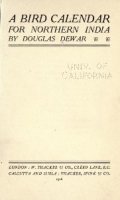Dewar’s Calendar — September
September is considered a very important month in the migration calendar, and is so wonderfully described by Douglas Dewar in his A Bird Calendar for Northern India, published in 1916.
| Great changes in the avifauna take place in September…the great autumnal immigration takes place throughout the month. Before September is half over the migratory wagtails begin to appear… They arrive in silence, but on the morning of their coming the observer cannot fail to notice their cheerful little notes, which, like the hanging of the village smoke, are to be numbered among the signs of the approach of winter. The three species that visit India in the largest numbers are the white (Motacilla alba), the masked (M. personata)* and the grey wagtail. In Bengal the first two are largely replaced by the white-faced wagtail (M. leucopsis)*… The three species arrive almost simultaneously, but the experience of the writer is that the grey bird usually comes a day or two before his cousins.On one of the last ten days of September the first batch of Indian redstarts # (Ruticilla frontalis) reaches India. Within twenty days of the coming of these welcome little birds it is possible to dispense with punkas.
Like the redstarts the rose-finches and minivets begin to pour into India towards the end of September. The snipe arrive daily throughout the month. With the first full moon of September come the grey quail ## (Coturnix communis). When the stream of immigrating quail has ceased to flow, these birds spread themselves over the well-cropped country. Thousands of blue-winged teal @ invade India in September, but most of the other species of non-resident duck do not arrive until October or even November. Not the least important of the September arrivals are the migratory birds of prey… The necessity of following their favourite quarry may account for the migratory habits of some birds of prey, but it does not apply to all. Thus, the osprey, which feeds almost exclusively on fish, is merely a winter visitor to India. Again, there is the kestrel. This preys on non-migratory rats and mice, nevertheless it leaves the plains in the hot weather and goes to the Himalayas to breed. All the species of birds of prey cited above as migratory begin to arrive in the plains of India in September. The merlins come only into the Punjab, but most of the other raptores spread over the whole of India. The various species of harrier make their appearance in September. These are birds that cannot fail to attract attention. They usually fly slowly a few feet above the surface of the earth so that they can drop suddenly on their quarry. They squat on the ground when resting, but their wings are long and their bodies light, so that they do not need much rest. Those who shoot duck have occasion often to say hard things of the marsh-harrier and the peregrine falcon, because these birds are apt to come as unbidden guests to the shoot and carry off wounded duck and teal before the shikari has time to retrieve them. Of the migratory birds of prey the kestrel is perhaps the first to arrive; the osprey and the peregrine falcon are among the last. Very few observations of the comings and the goings of the various raptorial birds have been recorded; in the present state of our knowledge it is not possible to compile an accurate table showing the usual order in which the various species appear. This is a subject to which those persons who dwell permanently in one place might with advantage direct their attention. |
* Now considered as a subspecies of White Wagtail
# Current name: Blue-fronted Redstart Phoenicurus frontalis
## Current name: Common Quail Coturnix coturnix
@ Current name: Common Teal Anas crecca
Taken, with grateful thanks, from Project Gutenberg.

